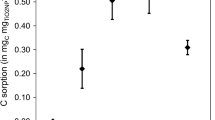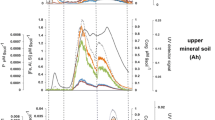Abstract
An increasing rate of the use of nanoparticles necessitates regarding them as a new class of toxicants. Nanodiamonds hold a special position because of their use in consumer goods, such as fuels and lubricants, which increases the risk of soil pollution with these nanoparticles. The goal of this study was to assess the effects of water-soluble soil components on the electrokinetic potential (ζ-potential) and size of detonation nanodiamonds. Water extracts from 15 zonal soil samples were studied. Addition of nanodiamonds to soil water extracts caused an increase in the weighted average hydrodynamic diameter of nanodiamonds from 24 to 69–683 nm and a drop in absolute ζ-potential from –22 to –(11.2–19.50) mV; an increase in the absolute ζ-potential to –34.5 mV was observed in one case. The highest increase in the size of nanodiamonds was detected in the extracts with high pH values and high Ca/(Fe + Al) ratio. The observed inverse correlation of the ζ-potential of nanodiamonds with the extinction coefficient of the dissolved soil organic matter \({\text{E}}_{{465}}^{{{\text{OC}},0.01\% }}\) and the iron content in water extracts suggested that the stability of nanodiamonds could increase in soil solutions in the presence of low molecular weight components of dissolved soil organic matter and at high iron concentrations. Generally, the obtained results allow us to assume that coagulation of nanodiamonds and a decrease in their mobility in soil are due to their interaction with water-soluble soil components. Water extracts from solonetzes are an exception, because the mobility of nanodiamonds in them may increase.




Similar content being viewed by others
REFERENCES
V. Yu. Dolmatov, Ultrafine Diamonds of Detonation Synthesis: Production, Properties, and Use (St. Petersburg Polytechnic University, St. Petersburg, 2003) [in Russian].
S. I. Kolesnikov, A. N. Timoshenko, K. Sh. Kazeev, Yu. V. Akimenko, and M. A. Myasnikova, “Ecotoxicity of copper, nickel, and zinc nanoparticles assessment on the basis of biological indicators of chernozems,” Eurasian Soil Sci. 52, 982–987 (2019).
“Before the jump,” V Mire Nano, No. 5, 25–28 (2010).
V. A. Terekhova and M. M. Gladkova, “Engineered nanomaterials in soil: problems in assessing their effect on living organisms,” Eurasian Soil Sci. 46, 1203–1210 (2013).
O. I. Filippova, V. A. Kholodov, N. A. Safronova, A. V. Yudina, and N. A. Kulikova, “Particle-size, microaggregate-size, and aggregate-size distributions in humus horizons of the zonal sequence of soils in European Russia,” Eurasian Soil Sci. 52, 300–312 (2019). https://doi.org/10.1134/S1064229319030037
V. A. Basiuk, T. Terrazas, N. Luna-Martínez, and E. V. Basiuk, “Phytotoxicity of carbon nanotubes and nanodiamond in long-term assays with Cactaceae plant seedlings,” Fullerenes, Nanotubes Carbon Nanostruct. 27 (2), 141–149 (2019). https://doi.org/10.1080/1536383X.2018.1531393
Zh. Bo, S. Y. Avzar, M. K. Corliss, M. Chung, and N.‑J. Cho, “Influence of natural organic matter (NOM) coatings on nanoparticle adsorption onto supported lipid bilayers,” J. Hazard. Mater. 339, 264–273 (2017). https://doi.org/10.1016/j.jhazmat.2017.06.031
T. Borodina, D. Trushina, V. Artemov, T. Bukreeva, and D. Shchukin, “Modification of the polyelectrolyte capsule shell by nanodiamonds for remote microwave opening,” Mater. Lett. 251, 81–84 (2019). https://doi.org/10.1016/j.matlet.2019.05.037
Y. Cai, S. X. Chang, B. Ma, and E. W. Bork, “Watering increased DOC concentration but decreased N2O emission from a mixed grassland soil under different defoliation regimes,” Biol. Fert. Soils 52, 987–996 (2016). https://doi.org/10.1007/s00374-016-1135-3
L. Degenkolb, M. Kaupenjohann, and S. Klitzke, “The variable fate of Ag and TiO2 nanoparticles in natural soil solutions—sorption of organic matter and nanoparticle stability,” Water, Air Soil Pollut. 230, 62 (2019). https://doi.org/10.1007/s11270-019-4123-z
S.-J. Gao, C. Zhao, Z.-H. Shi, J. Zhong, J.-G. Liu, and J.-Q. Li, “Spectroscopic characteristics of dissolved organic matter in afforestation forest soil of Miyun district, Beijing,” J. Anal. Methods Chem. 2016, 1480857 (2016). https://doi.org/10.1155/2016/1480857
Y. Gao, T. T. Yang, and J. Jin, “Nanoparticle pollution and associated increasing potential risks on environment and human health: a case study of China,” Environ. Sci. Pollut. Res. 22 (23), 19297–19306 (2015). https://doi.org/10.1007/s11356-015-5497-0
A. M. Hansen, T. E. C. Kraus, B. A. Pellerin, J. A. Fleck, B. D. Downing, and B. A. Bergamaschi, “Optical properties of dissolved organic matter (DOM): effects of biological and photolytic degradation,” Limnol. Oceanogr. 61 (3), 1015–1032 (2016). https://doi.org/10.1002/lno.10270
M. Ivanov and O. Shenderova, “Nanodiamond-based nanolubricants for motor oils,” Curr. Opin. Solid State Mater. Sci. 21, 17–24 (2017). https://doi.org/10.1016/j.cossms.2016.07.003
J. Jira, B. Rezek, V. Kriha, A. Artemenko, I. Matolínová, V. Skakalova, P. Stenclova, and A. Kromka, “Inhibition of E. coli growth by nanodiamond and graphene oxide enhanced by Luria-Bertani medium,” Nanomaterials 8 (140), (2018). https://doi.org/10.3390/nano8030140
J. Johnson, E. G. Pannatier, S. Carnicelli, G. Cecchini, N. Clarke, N. Cools, K. Hansen, H. Meesenburg, T. M. Nieminen, G. Pihl-Karlsson, H. Titeux, E. Vanguelova, A. Verstraeten, L. Vesterdal, P. Waldner, et al., “The response of soil solution chemistry in European forests to decreasing acid deposition,” Global Change Biol. 24, 3603–3619 (2018). https://doi.org/10.1111/gcb.14156
S. Lee, K. Kim, H. K. Shon, S. D. Kim, and J. Cho, “Biotoxicity of nanoparticles: effect of natural organic matter,” J. Nanopart. Res. 13 (7), 3051–3061 (2011). https://doi.org/10.1007/s11051-010-0204-z
V. N. Mochalin, O. Shenderova, D. Ho, and Y. Gogotsi, “The properties and applications of nanodiamonds,” Nat. Nanotechnol. 7, 11–23 (2012). https://doi.org/10.1038/nnano.2011.209
N. Nunn, M. D’Amora, N. Prabhakar, A. M. Panich, N. Froumin, M. D. Torelli, I. Vlasov, P. Reineck, B. Gibson, J. M. Rosenholm, S. Giordani, and O. Shenderova, “Fluorescent single-digit detonation nanodiamond for biomedical applications,” Methods Appl. Fluoresc. 6 (3), 035010 (2018). https://doi.org/10.1088/2050-6120/aac0c8
N. Nunn, M. Torelli, G. McGuire, and O. Shenderova, “Nanodiamond: a high impact nanomaterial,” Curr. Opin. Solid State Mater. Sci. 21, 1–9 (2017). https://doi.org/10.1016/j.cossms.2016.06.008
M. L. Pace, I. Reche, J. J. Cole, A. Fernandez-Barbero, I. P. Mazuecos, and Y. T. Prairie, “pH change induces shifts in the size and light absorption of dissolved organic matter,” Biogeochemistry 108, 109–118 (2012). https://doi.org/10.1007/s10533-011-9576-0
N. Saleh, H.-J. Kim, T. Phenrat, K. Matyjaszewski, R. D. Tilton, and G. V. Lowry, “Ionic strength and composition affect the mobility of surface-modified Fe0 nanoparticles in water-saturated sand columns,” Environ. Sci. Technol. 42 (9), 3349–3355 (2008). https://doi.org/10.1021/es071936b
T. M. Sanderson, Ch. Barton, C. Cotton, and T. Karathanasis, “Long-term evaluation of acidic atmospheric deposition on soils and soil solution chemistry in the Daniel Boone National Forest, USA,” Water, Air Soil Pollut. 228, 403 (2017). https://doi.org/10.1007/s11270-017-3583-2
G. E. Schaumann, A. Philippe, M. Bundschuh, G. Metreveli, S. Klitzke, D. Rakcheev, A. Grün, S. K. Kumahor, M. Kühn, T. Baumann, F. Lang, W. Manz, R. Schulz, and H.-J. Vogel, “Understanding the fate and biological effects of Ag- and TiO2-nanoparticles in the environment: the quest for advanced analytics and interdisciplinary concepts,” Sci. Total Environ. 535, 3–19 (2015). https://doi.org/10.1016/j.scitotenv.2014.10.035
W. Schön, F. Mittermayr, A. Leis, I. Mischak, and M. Dietzel, “Temporal and spatial variability of chemical and isotopic composition of soil solutions from Cambisols—field study and experiments,” Sci. Total Environ. 572, 1066–1079 (2016). https://doi.org/10.1016/j.scitotenv.2016.08.015
B. J. R. Thio, D. Zhou, and A. A. Keller, “Influence of natural organic matter on the aggregation and deposition of titanium dioxide nanoparticles,” J. Hazard. Mater. 189, 556–563 (2011). https://doi.org/10.1016/j.jhazmat.2011.02.072
H. Tinwala and S. Wairkar, “Production, surface modification and biomedical applications of nanodiamonds: a sparkling tool for theranostics,” Mater. Sci. Eng., C 97, 913–931 (2019). https://doi.org/10.1016/j.msec.2018.12.073
F. Visconti, J. M. de Paz, and J. L. Rubio, “Principal component analysis of chemical properties of soil saturation extracts from an irrigated Mediterranean area: implications for calcite equilibrium in soil solutions,” Geoderma 151 (3–4), 407–416 (2009).
F. Visconti, J. M. de Paz, and J. L. Rubio, “What information does the electrical conductivity of soil water extracts of 1 to 5 ratio (w/v) provide for soil salinity assessment of agricultural irrigated lands?” Geoderma 154, 387–397 (2010). https://doi.org/10.1016/j.geoderma.2009.11.012
L. Zehlike, A. Peters, R. H. Ellerbrock, L. Degenkolb, and S. Klitzke, “Aggregation of TiO2 and Ag nanoparticles in soil solution—effects of primary nanoparticle size and dissolved organic matter characteristics,” Sci. Total Environ. 688, 288–298 (2019). https://doi.org/10.1016/j.scitotenv.2019.06.020
Y. X. Zhang, W. J. Zhang, Y. Fedutik, Z. W. Mao, and C. Y. Gao, “Nanodiamonds of different surface chemistry influence the toxicity and differentiation of rat bone mesenchymal stem cells in vitro,” J. Nanosci. Nanotechnol. 19 (9), 5426–5434 (2019). https://doi.org/10.1166/jnn.2019.16545
Y. Zhu, Yu. Zhang, G. Shi, J. Yang, J. Zhang, W. Li, A. Li, R. Tai, H. Fang, Ch. Fan, and Q. Huang, “Nanodiamonds act as Trojan horse for intracellular delivery of metal ions to trigger cytotoxicity,” Part. Fibre Toxicol. 12 (2), (2015). https://doi.org/10.1186/s12989-014-0075-z
ACKNOWLEDGMENTS
The author thanks M.G. Chernysheva for her assistance in measurements using Zetasizer Nano ZS and A.B. Volikov for assaying the contents of organic and inorganic carbon.
Funding
The work was funded by the state budget (Center of Information Technologies and Systems no. 116020110002-8). The soil sampling was performed by N.A. Safonova within the framework of project no. 16-14-00167 of the Russian Science Foundation.
Author information
Authors and Affiliations
Corresponding author
Ethics declarations
The author states no conflict of interest.
Additional information
Translated by G. Chirikova
Rights and permissions
About this article
Cite this article
Kulikova, N.A. The Effects of Water-Soluble Soil Components on the Size and Electrokinetic Potential of Nanodiamonds. Eurasian Soil Sc. 53, 882–891 (2020). https://doi.org/10.1134/S106422932007008X
Received:
Revised:
Accepted:
Published:
Issue Date:
DOI: https://doi.org/10.1134/S106422932007008X




